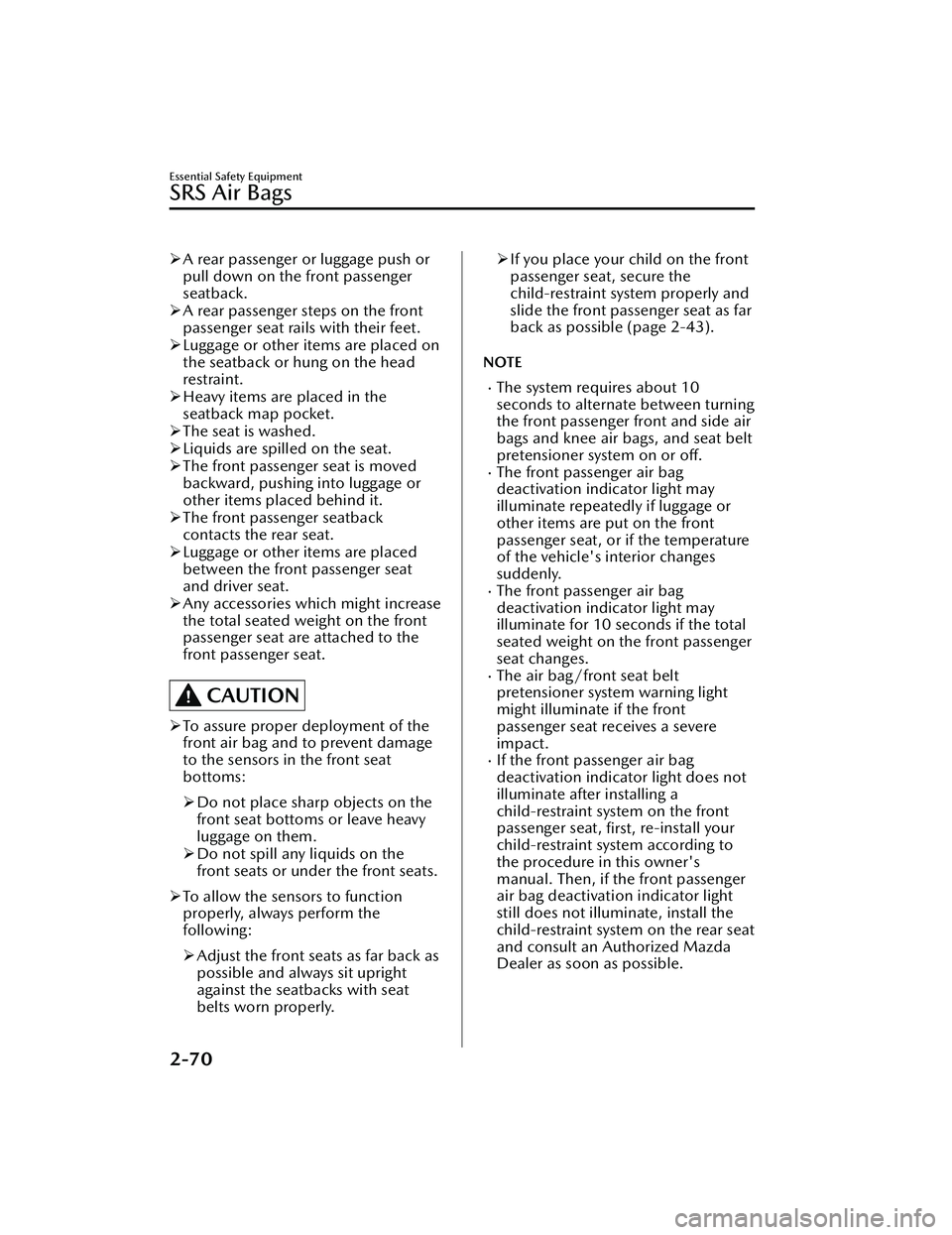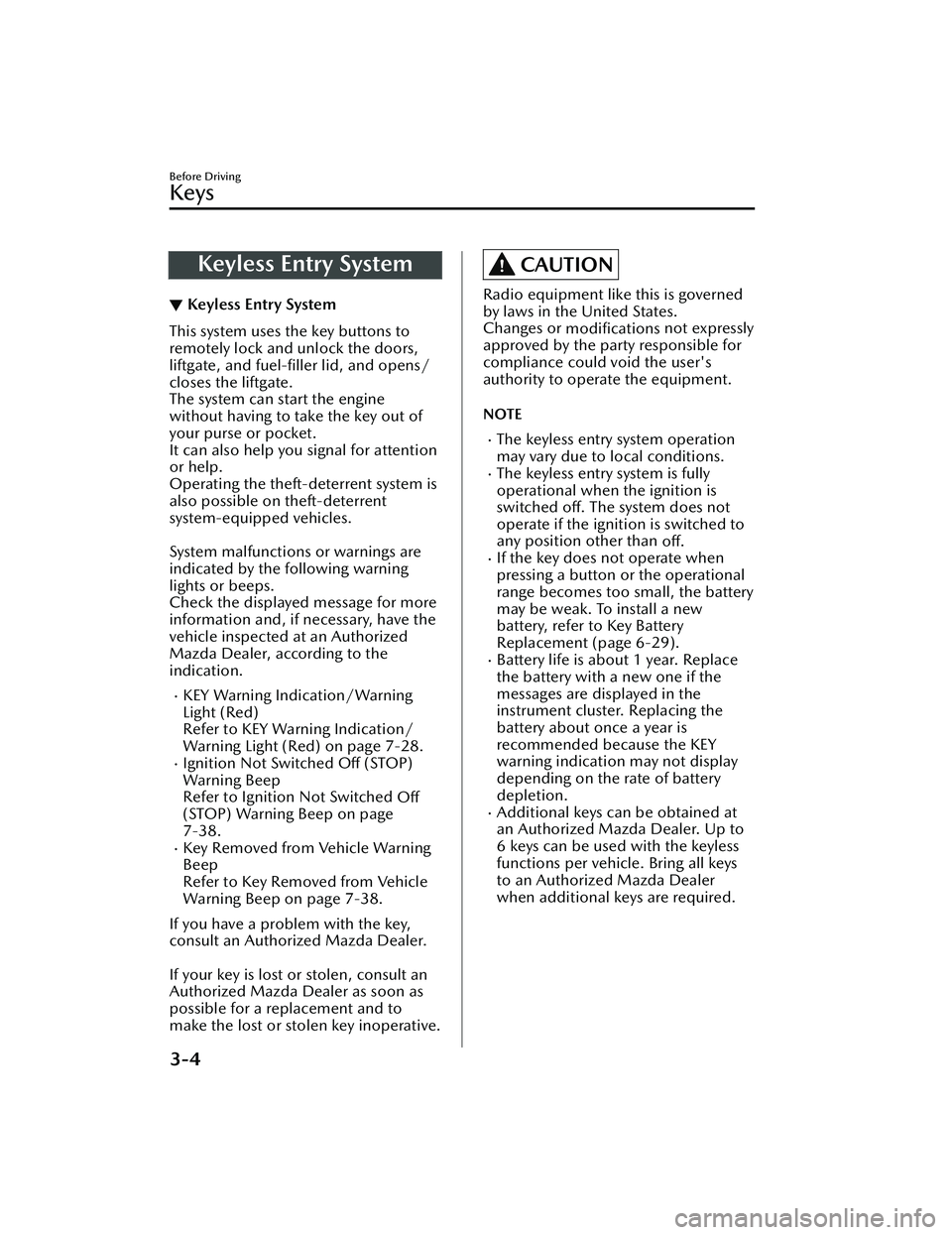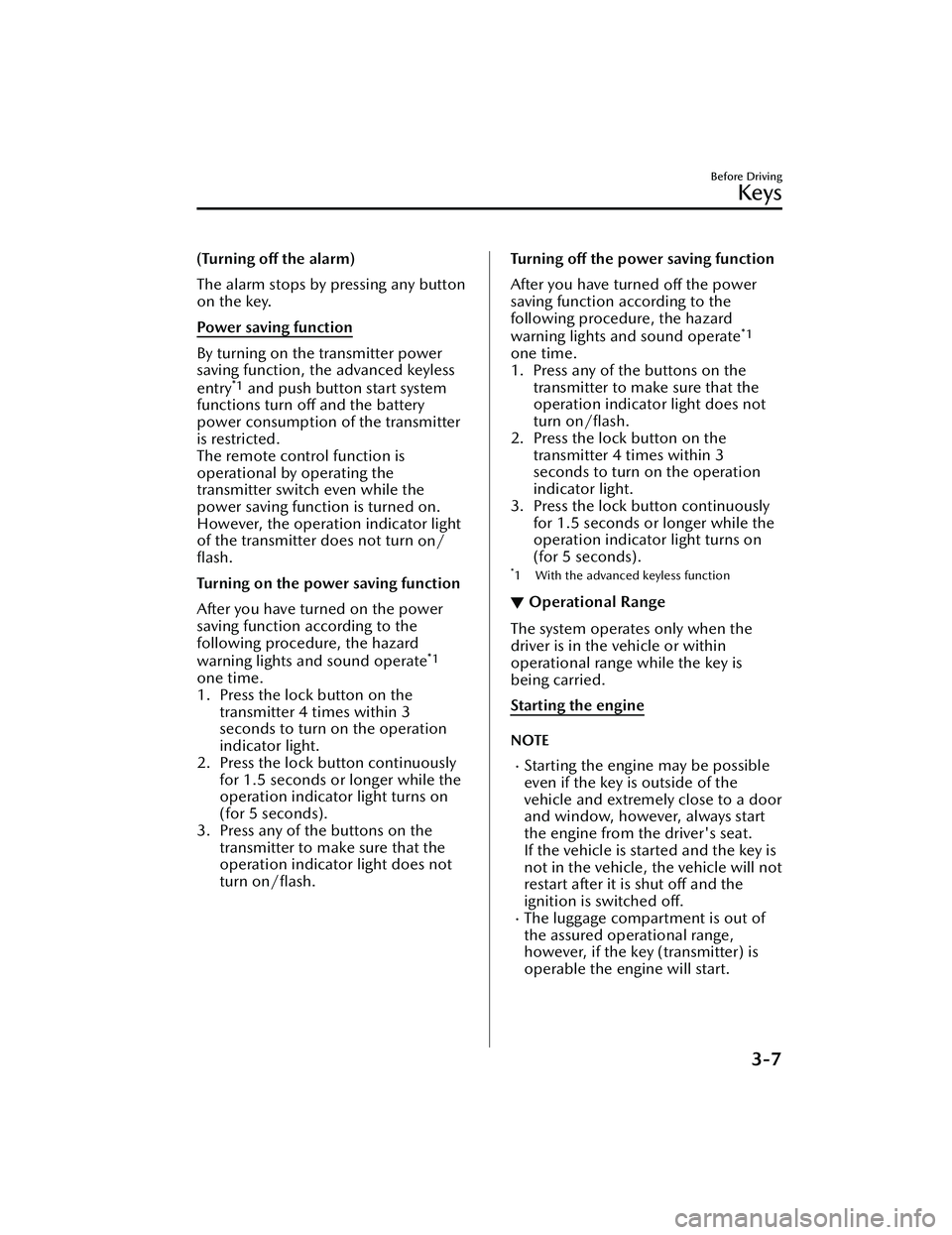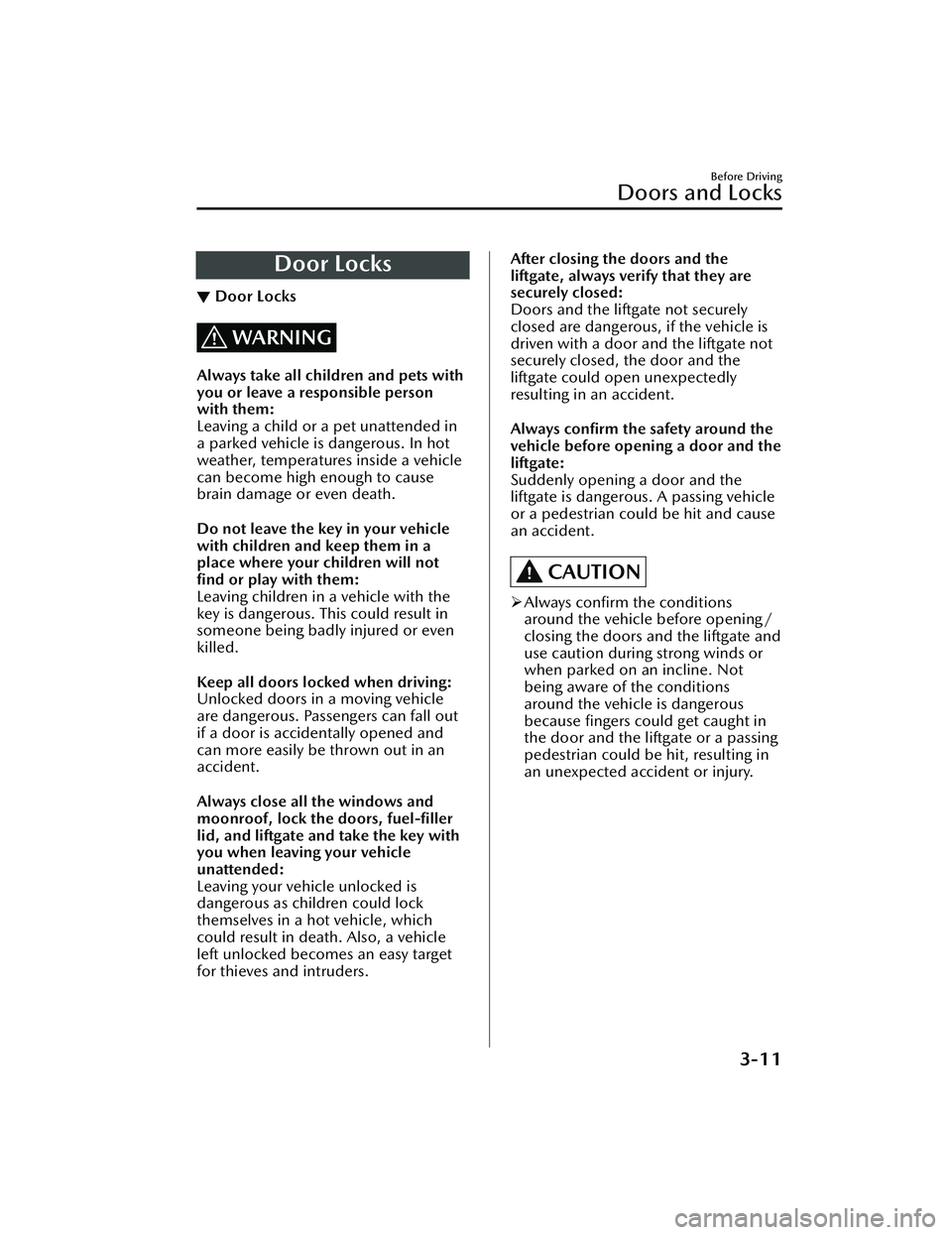ACC MAZDA MODEL CX-30 2021 Service Manual
[x] Cancel search | Manufacturer: MAZDA, Model Year: 2021, Model line: MODEL CX-30, Model: MAZDA MODEL CX-30 2021Pages: 594, PDF Size: 83.37 MB
Page 81 of 594

Limitations to SRS Air Bag
▼Limitations to SRS Air Bag
In severe collisions such as those
described previously in "SRS Air Bag
Deployment Criteria", the applicable
SRS air bag equipment will deploy.
However, in some accidents, the
equipment may not deploy depending
on the type of collision and its severity.
Limitations to front/near front
collision detection:
The following illustrations are
examples of front/near front collisions
that may not be detected as severe
enough to deploy the SRS air bag
equipment.
Impacts involving trees or poles
Frontal offset impact to the vehicle
Rear-ending or running under a
truck's tail gate
Limitations to side collision detection:
The following illustrations are
examples of side collisions that may
not be detected as severe enough to
deploy the SRS air bag equipment.
Side impacts involving trees or poles
Side impacts with two-wheeled
vehicles
Roll-over (Without Front Passenger
Occupant Classification System)
Essential Safety Equipment
SRS Air Bags
2-65
CX-30_8JP5-EA-20K_Edition1_new
2020-7-22 15:50:09
Page 82 of 594

Limitations to roll-over detection
(With Front Passenger Occupant
Classification System):
The following illustration is an example
of an accident that may not be
detected as a roll-over accident.
Therefore, the front seat belt
pretensioners and curtain air bags may
not deploy.
Pitch end over end
Driver and Front
Pa s s e n g e r O cc u p a n t
Classification System
*
▼ Driver and Front Passenger
Occupant Classification System
First, please read "Supplemental
Restraint System (SRS) Precautions"
(page 2-52) carefully.
▼Driver Seat Slide Position Sensor
Your vehicle is equipped with a driver
seat slide position sensor as a part of
the supplemental restraint system. The
sensor is located under the driver seat.
The sensor determines whether the
driver seat is fore or aft of a reference
position and sends the seat position to
the diagnostic module (SAS unit).
The SAS unit is designed to control the
deployment of the driver air bag
depending on how close the driver
seat is to the steering wheel.
The air bag/front seat belt
pretensioner system warning light
flashes
if the sensor has a possible
malfunction (page 2-62).
Essential Safety Equipment
SRS Air Bags
2-66*Some models.
CX-30_8JP5-EA-20K_Edition1_new 2020-7-22 15:50:09
Page 83 of 594

▼Front Passenger Seat Weight
Sensors
Your vehicle is equipped with a front
passenger seat weight sensors as a part
of the supplemental restraint system.
These sensors are located under both
of the front passenger seat rails. These
sensors determine the total seated
weight on the front passenger seat and
monitor the seat belt buckle for the
front passenger seat. The SAS unit is
designed to prevent the front
passenger front and side air bags and
knee air bags, and seat belt
pretensioner system from deploying if
the front passenger air bag
deactivation indicator light illuminates.
To reduce the chance of injuries
caused by deployment of the front
passenger air bag, the system
deactivates the front passenger front
and side air bags and knee air bags,
and also the seat belt pretensioner
system when the front passenger air
bag deactivation indicator light
illuminates. Refer to the following
table for the front passenger air bag
deactivation indicator light
illumination conditions.
This system shuts off the front
passenger front and side air bags and
knee air bags, and seat belt
pretensioner system, so make sure the
front passenger air bag deactivation
indicator light illuminates according to
the following table.
The air bag/front seat belt
pretensioner system warning light
flashes and the front passenger air bag
deactivation indicator light illuminates
if the sensors have a possible
malfunction. If this happens, the front
passenger front and side air bags and
knee air bags, and seat belt
pretensioner system will not deploy.
Front passenger air bag deactivation
indicator light
This indicator light illuminates to
remind you that the front passenger
front and side air bags and knee air
bags, and seat belt pretensioners will
not deploy during a collision.
Essential Safety Equipment
SRS Air Bags
2-67
CX-30_8JP5-EA-20K_Edition1_new
2020-7-22 15:50:09
Page 84 of 594

If the front passenger weight sensors
are normal, the indicator light
illuminates when the ignition is
switched ON. The light turns off after a
few seconds. Then, the indicator light
illuminates or is off under the following
conditions:
Front passenger air bag deactivation
indicator light on/off condition chart
Condition
detected by the
front pas-
senger oc- cupant
classifica- tion sys- tem Front pas-
senger air
bag deacti-
vation indi- cator light Front pas-
senger
front and side andknee air
bags Front
passen-
ger seat
belt pre-
tensioner
system
Empty
(Not occu-
pied) On
Deactivat-
ed Deacti-
vated
Child or
child-re-
straint sys-
tem
*1
On Deactivat-
ed Deacti-
vated
Adult
*2Off Ready Ready
*1 If a larger child sits on the front passenger seat, the sensors might detect the child as
being an adult depending on the child's
physique.
*2 If a smaller adult sits on the front passengerseat, the sensors might detect the person as
being a child depending on the person's
physique.
The curtain air bag is ready for inflating
regardless of what the front passenger air bag
deactivation indicator light on/off condition
chart indicates.
If the front passenger air bag
deactivation indicator light does not
illuminate when the ignition is
switched ON and does not illuminate
as indicated in the front passenger air
bag deactivation indicator light on/off
condition chart, do not allow a child to
sit in the front passenger seat and
consult an Authorized Mazda Dealer
as soon as possible. The system may
not work properly in an accident.
WARNING
Do not decrease the total seated
weight on the front passenger seat:
When an adult or large child sits on the
front passenger seat, decreasing the
total seated weight on the front
passenger seat required for air bag
deployment is dangerous. The front
passenger seat weight sensors will
detect the reduced total seated weight
condition and the front passenger front
and side air bags and knee air bags,
and the seat belt pretensioner system
will not deploy during an accident. The
front passenger will not have the
supplementary protection of the air
bag, which could result in serious
injury. Decreasing the total seated
weight on the front passenger seat
could result in an air bag not deploying
under the following conditions, for
example:
Essential Safety Equipment
SRS Air Bags
2-68
CX-30_8JP5-EA-20K_Edition1_new 2020-7-22 15:50:09
Page 85 of 594

A front passenger is seated as shown
in the following figure:A rear passenger pushes up on the
front passenger seat with their feet.
Luggage or other items placed under
the front passenger seat or between
the front passenger seat and driver
seat that push up the front passenger
seat bottom.
Any accessories which might
decrease the total seated weight on
the front passenger seat are attached
to the front passenger seat.
The front passenger front and side air
bags and knee air bags, and the seat
belt pretensioner system will
deactivate if the front passenger air
bag deactivation indicator light
illuminates.
Do not increase the total seated
weight on the front passenger seat:
When an infant or small child sits on
the front passenger seat, increasing the
total seated weight on the front
passenger seat is dangerous. The front
passenger seat we ight sensors will
detect the increased total seated
weight, which could result in the
unexpected deployment of the front
passenger front and side air bags and
knee air bags, and seat belt
pretensioner system in an accident and
may cause serious injury. Increasing the
total seated weight on the front
passenger seat could result in the front
passenger front and side air bags and
knee air bags, and seat belt
pretensioner system deployment in an
accident under the following
conditions, for example:
Luggage or other items are placed on
the seat with the child in the
child-restraint system.
Essential Safety Equipment
SRS Air Bags
2-69
CX-30_8JP5-EA-20K_Edition1_new 2020-7-22 15:50:09
Page 86 of 594

A rear passenger or luggage push or
pull down on the front passenger
seatback.
A rear passenger steps on the front
passenger seat rails with their feet.
Luggage or other items are placed on
the seatback or hung on the head
restraint.
Heavy items are placed in the
seatback map pocket.
The seat is washed.
Liquids are spilled on the seat.
The front passenger seat is moved
backward, pushing into luggage or
other items placed behind it.
The front passenger seatback
contacts the rear seat.
Luggage or other items are placed
between the front passenger seat
and driver seat.
Any accessories which might increase
the total seated weight on the front
passenger seat are attached to the
front passenger seat.
CAUTION
To assure proper deployment of the
front air bag and to prevent damage
to the sensors in the front seat
bottoms:
Do not place sharp objects on the
front seat bottoms or leave heavy
luggage on them.
Do not spill any liquids on the
front seats or under the front seats.
To allow the sensors to function
properly, always perform the
following:
Adjust the front seats as far back as
possible and always sit upright
against the seatbacks with seat
belts worn properly.
If you place your child on the front
passenger seat, secure the
child-restraint system properly and
slide the front passenger seat as far
back as possible (page 2-43).
NOTE
The system requires about 10
seconds to alternate between turning
the front passenger front and side air
bags and knee air bags, and seat belt
pretensioner system on or off.
The front passenger air bag
deactivation indicator light may
illuminate repeatedly if luggage or
other items are put on the front
passenger seat, or if the temperature
of the vehicle's interior changes
suddenly.
The front passenger air bag
deactivation indicator light may
illuminate for 10 seconds if the total
seated weight on the front passenger
seat changes.
The air bag/front seat belt
pretensioner system warning light
might illuminate if the front
passenger seat receives a severe
impact.
If the front passenger air bag
deactivation indicator light does not
illuminate after installing a
child-restraint system on the front
passenger seat,
first, re-install your
child-restraint system according to
the procedure in this owner's
manual. Then, if the front passenger
air bag deactivation indicator light
still does not illuminate, install the
child-restraint system on the rear seat
and consult an Authorized Mazda
Dealer as soon as possible.
Essential Safety Equipment
SRS Air Bags
2-70
CX-30_8JP5-EA-20K_Edition1_new 2020-7-22 15:50:09
Page 92 of 594

Keyless Entry System
▼Keyless Entry System
This system uses the key buttons to
remotely lock and unlock the doors,
liftgate, and fuel-filler lid, and opens/
closes the liftgate.
The system can start the engine
without having to take the key out of
your purse or pocket.
It can also help you signal for attention
or help.
Operating the theft-deterrent system is
also possible on theft-deterrent
system-equipped vehicles.
System malfunctions or warnings are
indicated by the following warning
lights or beeps.
Check the displayed message for more
information and, if necessary, have the
vehicle inspected at an Authorized
Mazda Dealer, according to the
indication.
KEY Warning Indication/Warning
Light (Red)
Refer to KEY Warning Indication/
Warning Light (Red) on page 7-28.
Ignition Not Switched Off (STOP)
Warning Beep
Refer to Ignition Not Switched
Off
(STOP) Warning Beep on page
7-38.
Key Removed from Vehicle Warning
Beep
Refer to Key Removed from Vehicle
Warning Beep on page 7-38.
If you have a problem with the key,
consult an Authorized Mazda Dealer.
If your key is lost or stolen, consult an
Authorized Mazda Dealer as soon as
possible for a replacement and to
make the lost or stolen key inoperative.
CAUTION
Radio equipment like this is governed
by laws in the United States.
Changes or modifications not expressly
approved by the party responsible for
compliance could void the user's
authority to operate the equipment.
NOTE
The keyless entry system operation
may vary due to local conditions.
The keyless entry system is fully
operational when the ignition is
switched off. The system does not
operate if the ignition is switched to
any position other than off.
If the key does not operate when
pressing a button or the operational
range becomes too small, the battery
may be weak. To install a new
battery, refer to Key Battery
Replacement (page 6-29).
Battery life is about 1 year. Replace
the battery with a new one if the
messages are displayed in the
instrument cluster. Replacing the
battery about once a year is
recommended because the KEY
warning indication may not display
depending on the rate of battery
depletion.
Additional keys can be obtained at
an Authorized Mazda Dealer. Up to
6 keys can be used with the keyless
functions per vehicle. Bring all keys
to an Authorized Mazda Dealer
when additional keys are required.
Before Driving
Keys
3-4
CX-30_8JP5-EA-20K_Edition1_new 2020-7-22 15:50:09
Page 95 of 594

(Turning off the alarm)
The alarm stops by pressing any button
on the key.
Power saving function
By turning on the transmitter power
saving function, the advanced keyless
entry
*1 and push button start system
functions turn off and the battery
power consumption of the transmitter
is restricted.
The remote control function is
operational by operating the
transmitter switch even while the
power saving function is turned on.
However, the operation indicator light
of the transmitter does not turn on/
flash.
Turning on the power saving function
After you have turned on the power
saving function according to the
following procedure, the hazard
warning lights and sound operate
*1
one time.
1. Press the lock button on the transmitter 4 times within 3
seconds to turn on the operation
indicator light.
2. Press the lock button continuously for 1.5 seconds or longer while the
operation indicator light turns on
(for 5 seconds).
3. Press any of the buttons on the transmitter to make sure that the
operation indicator light does not
turn on/flash.
Turning off the power saving function
After you have turned off the power
saving function according to the
following procedure, the hazard
warning lights and sound operate
*1
one time.
1. Press any of the buttons on the transmitter to make sure that the
operation indicator light does not
turn on/flash.
2. Press the lock button on the transmitter 4 times within 3
seconds to turn on the operation
indicator light.
3. Press the lock button continuously for 1.5 seconds or longer while the
operation indicator light turns on
(for 5 seconds).
*1 With the advanced keyless function
▼Operational Range
The system operates only when the
driver is in the vehicle or within
operational range while the key is
being carried.
Starting the engine
NOTE
Starting the engine may be possible
even if the key is outside of the
vehicle and extremely close to a door
and window, however, always start
the engine from the driver's seat.
If the vehicle is started and the key is
not in the vehicle, the vehicle will not
restart after it is shut off and the
ignition is switched off.
The luggage compartment is out of
the assured operational range,
however, if the key (transmitter) is
operable the engine will start.
Before Driving
Keys
3-7
CX-30_8JP5-EA-20K_Edition1_new
2020-7-22 15:50:09
Page 99 of 594

Door Locks
▼Door Locks
WARNING
Always take all children and pets with
you or leave a responsible person
with them:
Leaving a child or a pet unattended in
a parked vehicle is dangerous. In hot
weather, temperatures inside a vehicle
can become high enough to cause
brain damage or even death.
Do not leave the key in your vehicle
with children and keep them in a
place where your children will not
find or play with them:
Leaving children in a vehicle with the
key is dangerous. This could result in
someone being badly injured or even
killed.
Keep all doors locked when driving:
Unlocked doors in a moving vehicle
are dangerous. Passengers can fall out
if a door is accidentally opened and
can more easily be thrown out in an
accident.
Always close all the windows and
moonroof, lock the doors,
fuel-filler
lid, and liftgate and take the key with
you when leaving your vehicle
unattended:
Leaving your vehicle unlocked is
dangerous as children could lock
themselves in a hot vehicle, which
could result in death. Also, a vehicle
left unlocked becomes an easy target
for thieves and intruders.
After closing the doors and the
liftgate, always verify that they are
securely closed:
Doors and the liftgate not securely
closed are dangerous, if the vehicle is
driven with a door and the liftgate not
securely closed, the door and the
liftgate could open unexpectedly
resulting in an accident.
Always confirm the safety around the
vehicle before opening a door and the
liftgate:
Suddenly opening a door and the
liftgate is dangerous. A passing vehicle
or a pedestrian could be hit and cause
an accident.
CAUTION
Always confirm the conditions
around the vehicle before opening/
closing the doors and the liftgate and
use caution during strong winds or
when parked on an incline. Not
being aware of the conditions
around the vehicle is dangerous
because fingers could get caught in
the door and the liftgate or a passing
pedestrian could be hit, resulting in
an unexpected accident or injury.
Before Driving
Doors and Locks
3-11
CX-30_8JP5-EA-20K_Edition1_new 2020-7-22 15:50:09
Page 100 of 594

NOTE
Always stop the engine and lock the
doors. In addition, to prevent theft of
valuables, do not leave them inside
the cabin.
If the key is left in the following areas
and you leave the vehicle, the doors
may be locked depending on the
radio wave conditions even if the key
is left in the vehicle.
Around the dashboardIn the storage compartments such
as the glove compartment or the
center console
Next to a communication device
such as a mobile phone
When the ignition is switched to
ACC or ON, the vehicle lock-out
prevention feature prevents you from
locking yourself out of the vehicle.
All doors, fuel-filler lid, and liftgate
will automatically unlock if they are
locked using the power door locks
with any door or the liftgate open.
The vehicle lock-out prevention
feature does not operate while the
ignition is switched off.
When all doors, fuel-filler lid, and
liftgate are locked using the power
door lock with any door or the
liftgate open, the closed doors, fuel-filler lid, and liftgate are locked.
After that, when all doors and the
liftgate are closed, all doors and the
liftgate are locked. However, if the
key is inside the vehicle, all doors, fuel-filler lid, and liftgate are
automatically unlocked.
(With the advanced keyless
function)
The beep sound is heard for about
10 seconds to notify the driver that
the key has been left in the vehicle.
(Without the advanced keyless
function)
The horn sound is heard twice to
notify the driver that the key has
been left in the vehicle.
(Door unlock (control) system with
collision detection)
This system automatically unlocks the
doors, fuel-filler lid, and liftgate in
the event the vehicle is involved in an
accident to allow passengers to get
out of the vehicle immediately and
prevent being trapped inside. While
the ignition is switched ON and in
the event the vehicle receives an
impact strong enough to inflate the
air bags, all the doors, fuel-filler lid,
and liftgate are automatically
unlocked after about 6 seconds have
elapsed from the time of the
accident.
The doors, fuel-filler lid, and liftgate
may not unlock depending on how
an impact is applied, the force of the
impact, and other conditions of the
accident.
If door-related systems or the battery
is malfunctioning, the doors, fuel-filler lid, and liftgate may not
unlock depending on your vehicle
type.
Before Driving
Doors and Locks
3-12
CX-30_8JP5-EA-20K_Edition1_new 2020-7-22 15:50:09